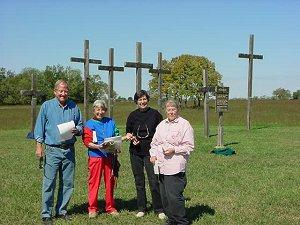|
By Shirley Willard, Fulton County Historian On the morning after the end of the Trail of Death caravan, the Grizzells, Prichards, Campbells and us Willards drove to Osawatomie for breakfast. We passed over the creek where we rescued Paxico Wabaunsee from the flood in 1993. After breakfast we said good-bye, Prichards headed home to Indiana, Grizzells took clothing to the Sioux Reservation in South Dakota, and Campbells went to visit relatives in Soldier, Kansas. Bill and I went to the Osawatomie Graphic office to show the reporter, Jennifer McDaniel, our Potawatomi adoption papers. She had been at the Shrine Sunday but had to leave before the end. She took our picture and e-mailed it to the Rochester Sentinel.
Then we drove back to the Shrine to get our camper. Ginger Pearl, Mary Ann Harty and Pat Dockry were still there, copying names from the seven crosses that list all the Potawatomi who died there 1838-48. They found many of their ancestors’ names. After they left, Bill and I walked in the woods and down to the Indian well the Potawtomi had dug in the 1830s. The St. Philippine Duchesne Memorial Park is 450 acres and a very peaceful place. There were deer, squirrels and lots of birds. The locations of the log mission buildings were marked with signs and outlined with white stones. Many religious markers are there, including the Fourteen Stations of the Cross. There are eight Trail of Death markers there now, including the Memorial Wall with plaques of 1838 diary, donated by Fulton County Historical Society in 1989, and the new Father Petit memorial, which we dedicated Sept. 28, 2003. We took digital pictures of all of them. On our way back home to Indiana, we saw that we were going through St. Charles, Mo., so we decided to stop and see the St. Philippine Duchesne Shrine. It was raining as we stopped to ask directions at a grocery store but the local people, even the Catholics, did not know about it. Finally one of them said it might be at the Sacred Heart Academy so the store manager phoned the Academy and I asked. Sure enough, the school is attached to the old church where St. Philippine is enshrined. The Academy officials said if we come back after lunch, they would have docents to give us a guided tour. So we went to eat at a nearby Subway and came back at 1:00. Two ladies from the class of 1940, Dody and Helen, were our guides. They told us the story of St. Philippine’s last few years of life there in St. Charles, and we told them about the Potawatomi Trail of Death. They had never heard of it. We gave copies of our Trail of Death booklets to both the shrine and the school. They showed us the little room where St. Philippine lived and died, and the sarcophagus where her remains lie. There are beautiful colored windows in the school library that depict scenes from her life: school in France and the French Revolution, crossing the ocean, living in St. Louis and St. Charles, and at the Potawatomi Mission. The scenes of her time as a missionary to the Potawatomi at Sugar Creek, Kansas, show teepees, but they actually lived in log cabins and wigwams there. When we left our guides, we hugged them and gave them Trail of Death Caravan badges. That night we stayed at our son Tom’s home in Shiloh, Ill. The next day, Oct. 1, we came on home. I was so tired I could not get my brains together to write for several weeks. I had not been able to sleep on the caravan but when I got home, all I could do was sleep. We had traveled 165 years in seven days. Since then we have been getting pictures and newspaper articles nearly every day. I will put them together to make a book, to be published by the Citizen Potawatomi Nation. It will come out next year. John Strathman teaches video production at Purdue University. He and his class have decided to make a documentary about the Trail of Death Regional Historic Trail for The History Channel. It will take three to five years to complete. The Fulton County Museum is the repository for all materials about the Trail of Death Regional Historic Trail and the caravans of 1988, 1993, 1998 and 2003. For more information or to be buy books about Potawatomi Trail of Death, contact the Fulton County Historical Society, 37 E 375 N, Rochester IN 46975, phone 574-223-4436, e-mail and web page: www.fultoncountyhistory.org. Potawatomi Trail of Death, ed. Shirley Willard and Susan Campbell, 448 pages, soft cover, Father Petit’s letters, 1838 diary of emigration, muster rolls, John Tipton letters, Chief Menominee, William Polke, St. Philippine Duchesne, pictures by George Winter, map by Tom Hamilton, biographies of Potawatomi families who had ancestors on Trail of Death, bibliography, index, $40 plus $6 shipping. Trail of Death Regional Historic Trail, 50 pages, plastic cover, accounts of caravans: 1988-2003, resolutions passed by the four state legislatures declaring the Trail of Death a Regional Historic Trail in 1994, list and pictures of all 74 Trail of Death markers. $7 plus $3 shipping. Trail of Death Diary, edited and condensed for 150th anniversary in 1988, plastic cover, 10 pages, $3 plus $2 shipping. |
| < Previous | Home | Next > |
